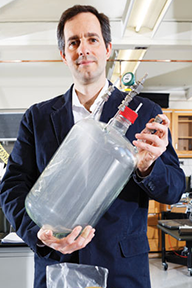Projecting Climate Change into the Future: What We Know and How Well We Know It
Science for the Public: Science Literacy Lecture Series
Speaker: Dan Cziczo | Associate Professor of Atmospheric Chemistry, Secondary Appointment - Civil and Environmental Engineering | Massachusetts Institute of Technology
Date: Tuesday, April 24, 2018 - 6:00pm to 7:00pm (Lecture - 6-6:30PM | Q&A - 6:30-7PM)
Since the early part of last century it has been known that greenhouse gases, like carbon dioxide, can lead to a warmer climate. Less well known was the effect that humans could have on clouds and how they might affect the Earth’s temperature. Historically, the study of the particles on which clouds form relied on the collection of precipitation (rain or snow). For example, particles at the center of snowflakes were assumed to have been responsible for the nucleation of ice. Studies showed the dominance of clay minerals with lesser abundances of combustion aerosols and micro-organisms. More recently, new inlets have allowed for more measurements from both ground sites and aircraft. The results have often been puzzling and at odds with previous work. We’ll discuss how measurement issues – such as technological limitations and artifacts – can impact that certainty with which we understand our climate and how it might change in the future. We will conclude with how this technology can be used to better understand climate and precipitation not only on Earth, but also for nearby and exoplanets.
It has been known for over a century that greenhouse gases such as carbon dioxide and methane warm the planet by trapping heat. What is not as well known is that particles can cool the planet by reflecting sunlight into space and by acting as the seeds on which clouds form. Particles and clouds are also of contemporary interest because it has been suggested they might affect climate by interacting with cosmic rays or be used to manipulate the Earth’s temperature.
Cziczo's research group is interested in the interrelationship of particulate matter and cloud formation. His team utilizes laboratory and field studies to elucidate how small particles interact with water vapor to form droplets and ice crystals, which are important players in the Earth’s climate system. Experiments include using small cloud chambers in the laboratory to mimic atmospheric conditions that lead to cloud formation and observing clouds in situ from remote mountaintop sites or through the use of research aircraft.
Current specific research interests include chemical composition of atmospheric aerosols with an emphasis on their effect on cloud formation mechanisms, Earth's radiative budget, and meteoritic debris and launch vehicle emissions in the atmosphere.
This series is hosted by Science for the Public - a grassroots nonprofit organization committed to improving public understanding of, and appreciation for, science. Visit the Science for the Public website for science info and for videos of other programs featuring outstanding scientists



